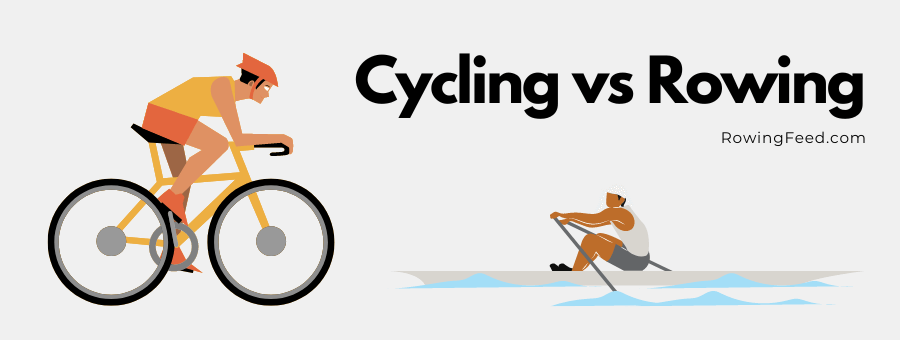In the world of fitness, choosing the right exercise equipment can make a significant difference in achieving your health and fitness goals. Two popular options that often come head-to-head are rowing machines and cycling.
While both offer excellent cardiovascular benefits, they differ in many aspects, including muscle engagement, calorie burning potential, and overall impact on your fitness journey. In this thorough guide, we’ll dive deep into the comparison between rowing and cycling to help you make an informed decision about which might be the better fit for your lifestyle and fitness objectives.
The Basics: Understanding Rowing and Cycling
Before we delve into the comparison, let’s briefly overview what each exercise requires:
Rowing:
Rowing is a full-body workout that simulates the action of rowing a boat. It involves a repetitive motion that engages multiple muscle groups simultaneously. The exercise is performed on a rowing machine, also known as an ergometer or “erg.”
Cycling:
Cycling, whether on a stationary bike or outdoors, primarily engages the lower body. It involves a circular pedalling motion that targets the legs and core. For this comparison, we’ll focus on indoor cycling using stationary bikes.
Efficiency and Time Commitment
One of the most significant factors in choosing an exercise routine is how well it fits into your lifestyle. Let’s compare rowing and cycling in terms of efficiency and time commitment:
Rowing:
• Highly efficient, full-body workout
• Typical session lasts around 20-30 minutes
• Ideal for those with busy schedules
• Provides both cardiovascular and strength training benefits in one session
Cycling:
• Great workout, but may require more time for equivalent calorie burn
• Sessions often last an hour or more
• Better for those who enjoy longer, steady-state cardio
• Primarily focuses on cardiovascular endurance
The efficiency of rowing makes it an attractive option for those with limited time. In just 20-30 minutes, you can get a comprehensive workout that engages virtually every major muscle group in your body. Cycling, while also beneficial, often requires longer sessions to achieve similar calorie-burning results.
Calorie Burning Potential
Both rowing and cycling are excellent for calorie burning, but the intensity of your workout plays a crucial role. Here’s a more detailed comparison of calories burned in one hour:
| Intensity | Cycling | Rowing |
| Low | 400-500 kcal | 400-500 kcal |
| Medium | 500-600 kcal | 600-700 kcal |
| High | 600-800 kcal | 700-1000 kcal |
At lower intensities, both exercises burn similar amounts of calories. However, as the intensity increases, rowing tends to burn more calories due to its full-body engagement. It’s important to note that these figures can vary based on factors such as body weight, age, gender, and individual fitness level.
The higher calorie-burning potential of rowing at high intensities makes it an excellent choice for those looking to maximize their calorie burn in a shorter amount of time. However, cycling can still be very effective for weight loss and maintenance, especially when done consistently over longer periods.
Muscles Involved in Cycling vs Rowing
One of the key differences between rowing and cycling lies in the muscle groups they engage:
Rowing:
• Full-body workout
• Engages approximately 86% of the body’s muscles
• Primary muscles worked: quadriceps, hamstrings, glutes, lats, core, biceps, triceps, shoulders, and back
• Builds overall strength and endurance
• Improves posture and core stability
Cycling:
• Primarily lower body workout
• Engages approximately 50% of the body’s muscles
• Primary muscles worked: quadriceps, hamstrings, glutes, and calves
• Some engagement of core and upper body for stability
• Excellent for leg strength and endurance
• Can improve balance and coordination
Rowing provides a more comprehensive muscle workout, engaging both the upper and lower body in a single fluid motion. This makes it an excellent choice for those looking to build overall strength and muscular endurance. Cycling, while primarily focusing on the lower body, is exceptional for developing leg strength and endurance. It’s particularly beneficial for those looking to target their lower body or complement upper body strength training routines.
You might also like to read: Is Rowing Good For Your Back?
Impact on Joints and Injury Risk
When choosing between rowing and cycling, it’s essential to consider the impact on your joints and the potential risk of injury:
Rowing:
• Low-impact exercise when performed with proper technique
• Minimal stress on joints, making it suitable for people with joint issues
• Risk of lower back strain if proper form is not maintained
• Requires some instruction to ensure the correct technique
Cycling:
• Very low-impact exercise
• Minimal stress on joints, excellent for people with joint problems
• Lower risk of injury compared to high-impact activities like running
• Easier to maintain proper form, even for beginners
Both rowing and cycling are considered low-impact exercises, making them suitable for people of various fitness levels and ages. However, cycling may have a slight edge in terms of being gentler on the joints, especially for those with existing joint issues or injuries.
Cardiovascular Health Benefits
Both rowing and cycling offer significant cardiovascular benefits:
• Improved heart health
• Increased lung capacity
• Lower resting heart rate
• Reduced risk of cardiovascular diseases
• Better circulation
• Increased stamina and endurance
While both exercises are excellent for cardiovascular health, rowing might have a slight advantage due to its full-body engagement, which can lead to a higher heart rate and greater overall cardiovascular demand.
Convenience and Accessibility
When it comes to incorporating these exercises into your routine, consider the following factors:
Rowing:
• Requires a rowing machine, which can be a significant investment
• Many gyms offer rowing machines
• Compact home models are available for those with limited space
• Can be done year-round indoors
• No need for special clothing or shoes
Cycling:
• Can be done outdoors on a regular bike or indoors on a stationary bike
• Stationary bikes are often more affordable than rowing machines
• Many gyms offer stationary bikes and spinning classes
• Can be enjoyed as a recreational activity outdoors
• Requires appropriate clothing and shoes for comfort and safety
Cycling offers more versatility in terms of indoor and outdoor options, while rowing is typically confined to indoor spaces unless you have access to actual rowing facilities.
Which One Should You Choose?
The choice between rowing and cycling ultimately depends on your personal goals, preferences, and circumstances. Here’s a summary to help you decide:
Choose Rowing If:
• You want a full-body workout that builds overall strength and endurance
• You’re short on time and need an efficient, high-calorie-burning exercise
• You enjoy high-intensity, varied movements
• You’re looking to improve your posture and core strength
• You prefer indoor workouts
Choose Cycling If:
• You prefer focusing on lower body strength and endurance
• You enjoy longer, steady-state cardio sessions
• You want a very low-impact option that’s extremely easy on the joints
• You like the option of exercising outdoors
• You enjoy group fitness classes like spinning
Remember, the best exercise is the one you enjoy and will stick with consistently. Both rowing and cycling are excellent forms of cardiovascular exercise that can significantly improve your fitness level when done regularly.
Conclusion
Both rowing and cycling offer unique benefits that can contribute significantly to your overall fitness and health. Rowing provides a more comprehensive full-body workout, engages more muscles, and can burn more calories in less time. It’s an excellent choice for those looking for efficiency and overall body conditioning. Cycling, on the other hand, is unbeatable for its low-impact nature, accessibility, and ability to be enjoyed both indoors and outdoors.
Ultimately, the choice between rowing and cycling should align with your personal fitness goals, time availability, and what you find most enjoyable. Many fitness enthusiasts even incorporate both into their routines to benefit from the unique advantages of each.
At RowingFeed, I’m passionate about helping you find the perfect rowing machine for your needs. If you’ve decided that rowing is the right choice for you, or if you’re looking to add it to your existing fitness routine, check out my recommended rowing machines to start your rowing journey today. Remember, consistency is key in any fitness regimen, so choose the exercise that you’ll look forward to doing regularly.
Excited to start your rowing or cycling journey? Let me share my favorite equipment picks with you!
For Rowing Enthusiasts:

The Concept2 Model D Rowing Machine has always been my top choice that offers a smooth, quiet ride and robust build quality; perfect for home as well as commercial use.
For Cycling Fans:

YOSUDA’s Classical Model Bike provides adjustable resistance levels and a comfortable seat for long rides.
I have thoroughly tested both these machines and they offer excellent value for money, in my opinion. By using these links, you’ll get a great piece of machine and support RowingFeed in creating more helpful content like this.


